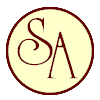

Acrylic Paint Materials information for Artists , instructions, hints and tips


Hints and Tips Artist Acrylics Paint Materials Information
| Acrylic surface preparation from Liquitex | Super Heavy Gesso from Liquitex | |
| Click Here for the Liquitex Book in pdf download format | Liquitex Acrylics Instructions Hints and Tips | |
| An innovative, impasto acrylic gesso used to prepare painting
surfaces for artists acrylic and oil paint. Create thick sculptural applications on various material and surfaces. Excellent ground for acrylic and oil paint. Mix with acrylic colour to have a tinted ground. Flexible, non-cracking and non-yellowing when dry. Provides the perfect "tooth" and adhesion to a wide variety of supports such as canvas, paper and wood Excellent base coat primer for many applications such as murals One coat is usually enough. Application : For canvas, paper, wood, or any clean, porous, non-oily surface. Tint colour with Liquitex Soft or Heavy Body Artist Colours. Use with knife or brush |
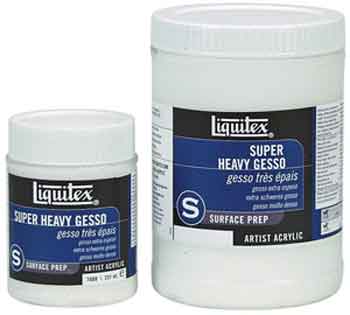 |
|
| Clear Gesso from Liquitex | New improved | |
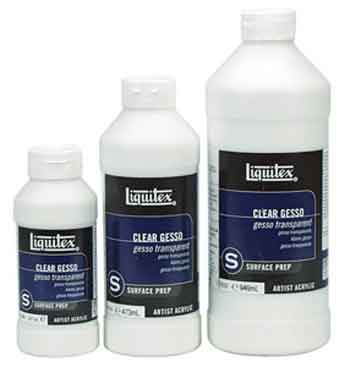 |
A very clear size and ground that keeps your working surface
visible. Ideal high tooth for pastel, oil pastel, graphite, and charcoal Excellent ground for acrylic and oil paint. Mix with acrylic colour to have a tinted ground. Dries clear to translucent depending on thickness. Flexible, non-cracking and non-yellowing when dry. Provides the perfect "tooth" and adhesion to a wide variety of supports such as canvas, paper and wood Excellent base coat primer for many applications such as murals Application Instructions For canvas, paper, wood, or any clean, porous, non-oily surface. Sizes and primes while maintaining the original appearance of the support material or surface. Provides paper with good tooth for chalk and oil pastel techniques. Mix with a very small amount of transparent or translucent acrylic colour to tint the ground while maintaining transparency. |
|
| Liquitex Acrylics Hints and Tips | ||
|
Palette wetting spray for acrylics in a 237 ml spray bottle from Liquitex An innovative, fluid acrylic resin designed to slow the drying of acrylic colours Allows you to keep your palette colours fresh longer, preventing the paint from skinning over. ‚ Improves colour blending Can be used to thin colour while maintaining film integrity. Formulated with an anti-microbial agent to prevent mould. Application : Use repeatedly to re-wet palette |
 |
|
 |
Soft Body. Produces a range of iridescent or metallic colours when
mixed into acrylic colours. Opaque when wet, transparent - translucent when dry. Will not oxidize. Mix with small amounts of Color, gradually adding more Color until desired iridescent quality and transparency is achieved. Transparent and translucent colours work best. Opaque colours can also be used. Color will become more transparent as percentage of medium increases. Colours increase in their iridescent quality and become much more reflective upon drying. For Mother of Pearl Color, use directly from container. For use on fabric, thin 50% with water. |
|
Cryla Artists Heavy Body Paint Acrylic colours are characterised by their thick buttery consistency, their uniform
eggshell finish across all the colours in the range and their minimal colour shift from wet to dry in the development of Cryla.
Daler-Rowney took the industry standards ASTM D5098 set by the American Society for Testing and Materials as their yardstick - and
improved on them at every stage of manufacture. Cryla Artists Heavy Body colours are designed to retain the intended stroke when
applied with a
palette knife or
brush, so they are ideal
material for highly textured impasto painting techniques and processes. | ||||||||||||||
Daler Rowney System 3 is a high quality versatile water based acrylic paint ideal for art, craft and design projects in colleges and schools. They are also ideal for the amateur and professional painter using colour in large quantities. Only high quality pigments are used in the manufacture of System 3 Acrylics, with a greater loading than other colours in their class. It offers an excellent painting experience at a most economical price. System 3 offers all the virtues of light fastness, permanence, covering power and flexibility. Available in a range of 35 colours in sizes from 75ml to 2.25 litres.
Daler Rowney System 3 Colour Chart
- Click Here
| ||||||||||||||
|
|
Mahl Stick Artist's Support |
| Two piece lightweight robust metal with cork head and suede leather covering. Provides a stable support for artists hands during prolonged periods of detail work over a canvas or artwork Size Length 895mm Manufacturer: Daler Rowney Ref. 3185 - 802 000 902 |
| > Reeves Introductory Level Acrylic Paints |
| Entry level inexpensive paints ideal for students |
| Acrylic Colour Tube Sets As a painting medium, acrylic colour has been increasingly appreciated for its particular merits: quick drying, use and clean up with water, versatility of technique and ease of use. Acrylics can be used straight from the tube to create impasto effects and build volume, like oil colour, or be diluted with water to use for water colour or poster colour techniques. Acrylics are suitable for use on all non-greasy surfaces including canvas, paper, wood, leather, brickwork etc. |
|
| One issue with acrylic paint is that they do dry very quickly and once dry are difficult to move. This can lead to problems with caps on tubes being difficult to undo after the tube gets a little older. The obvious solution is to thoroughly clean not only brush's, palettes and other equipment immediately after use, but for the humans amongst us a way to keep the skin on your fingers is to keep some general use pliers at hand to give that added purchase on the smaller caps. |
To keep acrylic paint usable once the paint has been squeezed out of the tube an acrylic retarder can be mixed with the colour which gives you more time for working. There are staywet palettes which keep the humidity around the paint high so keeping the colours moist and workable longer ( up to several days in certain circumstances), a washing up bowl with tissue and a layer of grease proof paper for mixing on will do a similar job. Also a misting spray over your palette once in a while will also keep the paints longer and when blending paints working on wet paper will also give you more time. Individual photographic film canisters with the sealable plastic top and other small jars will also keep paint workable , the smaller the amount of air in the jar the longer the paint will last. |
| Click Here for Cryla Acrylic colour chart | Click Here for System 3 colour chart | |
| Click Here for Brush information |
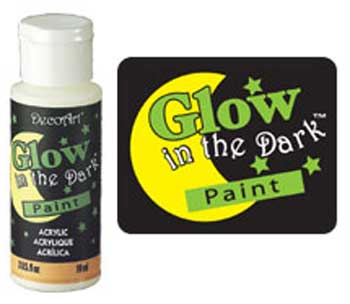 Phosphorescent Gel Glow in the Dark paint click here to buy online will absorb natural or artificial light and emit it in the dark, a transparent coloured gel that should be applied thickly |
Glow In The Dark paint will add luminescence to most surfaces
when charged with light. May be used alone or mixed with lighter
colours of acrylics. Ideal for Halloween crafts, adding stars to
the walls of kids' rooms, and decorative painting highlights. Medium must be mixed with the paint appropriate for the chosen surface. Painting Surfaces: Wood Paper mache Walls Decorative Halloween costumes Glass Ceramics Candles Styrofoam Poster board Features and Advantages: Soap and water cleanup Non-toxic Additional Decorating Ideas/Applications: Use over stencilled designs on walls and ceilings (stars, moons, etc.) Helpful Hints: Works best with light or transparent colours. When using on fabrics, add Fabric Medium, following label instructions for drying and heat setting. Click here to buy online Glow in Dark fabric paint 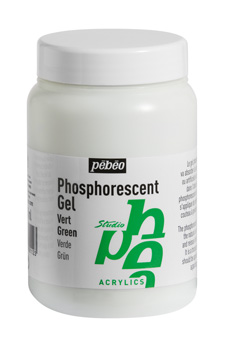 |
|

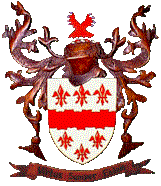
Dodgson Fine Arts Limited
Registered in Cardiff: No. 2790288
|
|
Back to Hints and Tips Index page
For further information and help
please telephone 01524 68014 between 9 am and 5 pm Monday - Saturday
or email help@studioartshop.co.uk
Registered Office:
50 North Road Lancaster England LA1 1LT
Tel: +44 (0)1524 68014
VAT No. 155 6324 65
Copyright © Studio Arts. All Rights Reserved.